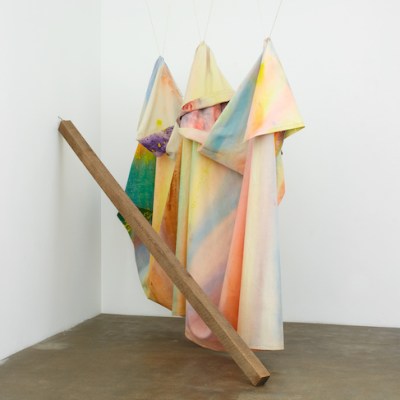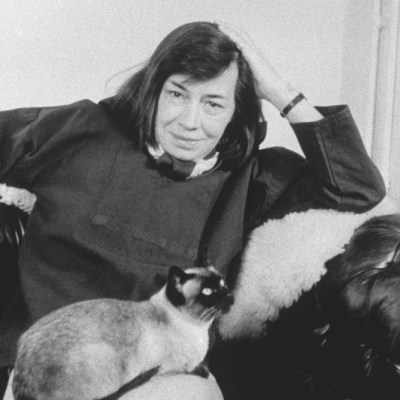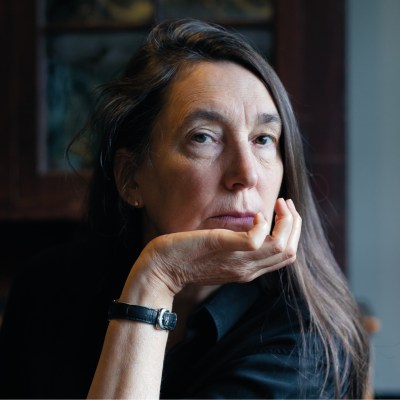From the April 2021 issue of Apollo. Preview and subscribe here.
Once upon a time, you could stand on the roof of 548 West 22nd Street, up among the water towers of Manhattan, with views out over the Hudson to New Jersey, and watch the city shimmer and reflect on the surfaces of one of Dan Graham’s glass pavilions. It was a New York moment. You could go downstairs, following the blue and green glow of a Dan Flavin light sculpture lining the stairwell, and see shows by leaders in contemporary European and American art reaching back to the 1960s. The galleries here, at Dia Center for the Arts, were some of the first to display Richard Serra’s Torqued Ellipses; they were the first in the United States to exhibit Gerhard Richter’s Atlas project in its entirety; and they staged major shows by Ann Hamilton, Robert Gober and Katharina Fritsch among many, many others. And then one day it was all over.
Rooftop Urban Park Project (1981–91), Dan Graham, installed on the roof of the Dia Center for the Arts at 548 West 22nd Street in Chelsea, New York. Photo: Bill Jacobson Studio, New York; courtesy Dia Art Foundation, New York; © Dan Graham

Jessica Morgan, the director of Dia Art Foundation, remembers it well. She was a curator at Tate in the early 2000s, and having come to New York to see some shows she found herself peering through dusty windows at abandoned galleries. ‘Gosh, what happened to Dia?’ she wondered. Not so long before it closed in 2004, the Cuban-born artist and designer Jorge Pardo had redesigned the whole of the first floor, laying down tiles that gave the rooms a lemon-yellow accent, and installing a full-scale model of a Volkswagen Beetle that made the entrance look like a conceptual car showroom. It all lay empty and forlorn.
Dia, a legendary and eccentric art foundation, emerged out of the experimental soil of the 1960s and ’70s, backing artists such as Donald Judd, Walter De Maria and Michael Heizer on wildly ambitious projects across the United States. In the process it acquired one of the world’s most outstanding collections of minimalist and post-minimalist art, a collection it finally succeeded in opening to view in 2003 in an old biscuit packaging factory in the sleepy town of Beacon in upstate New York. Fanfare ensued and Dia’s triumph was proclaimed – but its galleries in New York City closed soon afterwards, and a long, long lull ensued.
I recently sat down with Morgan in offices just across the street from Dia’s old address in Chelsea. Morgan, who is British, became the director of the foundation in 2015 via a transatlantic career path, working first at the Art Institute of Chicago and then as chief curator at the ICA Boston before a 12-year stint at Tate Modern. When she took its helm, Dia had for some time lacked a clear sense of direction, at least when it came to the foundation’s possible return to Manhattan: it had sold the building that housed its galleries in 2007, giving rise to a confusing array of plans, many of which were later abandoned.
Sun Tunnels (1973–76), Nancy Holt, installed in the Great Basin Desert, Utah. Dia Art Foundation. Photo: ZCZFilms/James Fox; courtesy Holt/Smithson Foundation; © Holt/Smithson Foundation and Dia Art Foundation/Licensed by VAGA at Artists Rights Society (ARS), NY

Dia’s low profile in New York City is finally set to end this month with the opening of expanded and renovated premises in Chelsea. The foundation’s three adjacent buildings on West 22nd Street have been merged into a single venue that includes 20,000 sq ft of exhibition space. Also scheduled soon is the creation of Dia SoHo, an additional exhibition space to complement the two spaces that the foundation already controls in SoHo, which have long been the homes of permanent installations by De Maria, The Broken Kilometer (1979) and The New York Earth Room (1977). This will add to the long list of sites Dia oversees, from Nancy Holt’s Sun Tunnels (1973–76) and Robert Smithson’s Spiral Jetty (1970) in Utah, to De Maria’s Vertical Earth Kilometer (1977) in Kassel, Germany.
Spiral Jetty (1970), Robert Smithson, on the shore of Great Salt Lake in Utah (photographed by Nancy Holt). Dia Art Foundation. Courtesy Dia Art Foundation, New York; © Holt/Smithson Foundation and Dia Art Foundation/Licensed by VAGA at Artists Rights Society (ARS), NY

If this sounds like a return to form for Dia, perhaps more significantly it reflects the refreshing stability that has coincided with Morgan’s tenure. For rather than being quiet all those years ago, Dia was rocked by a succession of stormy departures. The vast space at Beacon was the outcome of a close and fruitful relationship between a former director, Michael Govan, and the collector and Barnes & Noble founder Leonard Riggio. Govan had carefully cultivated Riggio – a man not naturally given to the elite social circles of New York philanthropy – and encouraged him to buy for the collection and give to the building. But when, in 2006, Govan abruptly left for the position he now occupies as director of the Los Angeles County Museum of Art, Riggio felt betrayed and quit the board. (With him went the hopes of a new space in downtown Manhattan, and that prize real estate is now the home of the Whitney Museum.) Things didn’t get much better after the dust settled from Govan’s departure. In 2008, the French curator Philippe Vergne took over and led the acquisition of 541 West 22nd Street, a key component of Dia’s new expansion. But when he deaccessioned works by Cy Twombly, John Chamberlain and Barnett Newman, another storm erupted. Vergne left swiftly thereafter.
For some institutions, these might have been isolated problems. For Dia it was familiar territory, however, and in many ways understandable given the wonderful and strange art world that the foundation emerged from. It was the brainchild of Heiner Friedrich, a German gallerist who tried unsuccessfully to bring public artwork by the likes of Carl Andre, Andy Warhol and Dan Flavin to Munich when the city hosted the Olympics in 1972. Frustrated, he left for New York, established a gallery and began working with Michael Heizer to realise projects in the Nevada desert. When he attempted to lure the Houston-based collectors, John and Dominique de Menil, to see Heizer’s work, they sent in their place a postgraduate student, Helen Winkler. Winkler was beguiled, moved to New York to work with Friedrich and introduced him to the De Menils’ daughter, Philippa, who was similarly impressed – so much so that she later married Friedrich. The two established Dia, along with Winkler, in 1974.
A work by Dan Flavin by the entrance to the new Dia Chelsea. Photo: Elizabeth Felicella

Dia means ‘through’ in Greek, which neatly encapsulates the foundation’s early aims. Seeing that there was a broad enthusiasm among young artists to create avant-garde art projects on a hitherto unseen scale, and realising that there would be few collectors able or willing to support them, the founders of Dia envisaged it as a midwife that would help bring such works into being. Of course, it depended ultimately on a patron with a singular faith in the project, Philippa de Menil herself, who used her inheritance to bankroll its far-reaching plans. Some of those now look like sound and enduring investments, such as De Maria’s The Lightning Field (1977), an extraordinary array of 400 stainless-steel poles laid out in a grid in the high desert of western New Mexico. Others, while fruitful artistically, were money-pits. Donald Judd was one of the more demanding artists supported by Dia, which granted him a vast stipend while he colonised the town of Marfa in Texas, building warehouses dedicated to displaying his work. The foundation was prophetic in its faith in new art; but it was crazed, too, in its organisational and financial undertakings. A reckoning was inevitable, and it came in the early 1980s when the oil crisis crushed the value of De Menil’s inheritance. Works were sold, staff numbers were cut and stipends stopped. But, against the odds, Dia endured.
While the foundation’s early engagement with post-minimalist art was vital in shaping its unconventional approach to patronage, the crisis of the 1980s had the unforeseen effect of making that early activity powerfully defining – and limiting, perhaps. As Morgan says, ‘When the collection was started by our founders, no one set out to have a collection of ’60s and ’70s art. […] But by happenstance, there was a crisis in Dia’s funding in the ’80s which meant that collecting came to halt, and it wasn’t until Beacon opened in 2003 that anything was added to the collection. That meant that there was a gap of almost 30 years of collecting. So Michael [Govan] clearly made the decision to stick within that historical moment and added Agnes Martin and Richard Serra, On Kawara and a few others.’
Double Merge (1968), Sam Gilliam, installation view at Dia Beacon, New York, in 2019. Photo: Bill Jacobson Studio, New York; courtesy Dia Art Foundation, New York; © Sam Gilliam/Artists Rights Society (ARS), New York

Morgan has decided to continue with this aspect of Dia’s activity, adding major work from the same period, and she’s pleased with the acquisitions she has overseen. ‘We’ve been pretty active,’ she says, ‘There are two parts to that. We don’t generally acquire single pieces – unless they’re like a Sam Gilliam, an extraordinary, singular piece that occupies an enormous gallery.’ Dia recently acquired a work by Gilliam, an African-American artist who emerged out of the colour field abstraction of the 1970s. Double Merge (1968/2019) is a sculptural cloud of canvas, stained with colour, which currently unfurls across a whole gallery at Beacon. Generally, however, the foundation has been acquiring broad overviews of artists’ work, like that of the American artist Dorothea Rockburne, acquisitions that have yielded a series of exhibitions since 2018. If Dia has been consolidating its strong holdings of art from the 1960s and ’70s, it has also done so while championing the work of previously overlooked figures, often women and people of colour. These are commitments that run deep and demand substantial resources, so Dia has been moving slowly and deliberately. In the six years that Morgan has been director, the foundation has added works by around 20 artists to its holdings. While that may not sound like many, it’s a seismic shift for the foundation, which still has only around 50 artists in its collection.
Key to Dia’s future is a flexible approach to expanding the focus beyond the 1960s and ’70s, and new commissions play an important role in this. The three shows already planned for the new Chelsea galleries are commissions from mid-career women artists, with the American artist Lucy Raven first up (16 April–January 2022). Raven’s exhibition will feature two works, a film, Ready Mix (2021), which was shot at a concrete plant in Idaho, and an installation of light sculptures inspired by rotocasters, devices used to mould objects in the round. Both works concern industrial processes of forming and shaping, and while they might be entirely contemporary in their inspiration, they owe a considerable debt to figures who emerged in the 1960s, such as Robert Smithson, Robert Morris and Richard Serra – artists who have a central place in Dia’s pantheon, and who were also fascinated by industrial processes and materials.
Film still from Ready Mix (2021), Lucy Raven. Courtesy the artist; © Lucy Raven

Just as Dia once gave unstinting support to artists with few commercial prospects, so it is now backing a new generation. Raven, for example, despite a record of international shows, has never had a solo exhibition in New York and has no commercial gallery representation. ‘We tend to work with people for an incredibly long period of time, and we really let them choose where they want to be,’ Morgan says. ‘We’re interested in people who have a life project. So, we’re not interested in artists who make paintings like Agnes Martin’s, necessarily, but we’re really interested in artists who, like Agnes Martin, have this absolute conviction in what they’re doing – and who follow it through with consistency, which often – let’s face it – leads them to a place where they really need institutional support because it’s not something that’s going to be particularly commercially viable.’
That experimental spirit is licensed in part by the great enthusiasm for Dia among younger visitors. Morgan was startled to learn that 58 per cent of visitors to Dia Beacon are under 35. There is frustration with the fact that some only make the visit once, resisting the 90-minute train ride out of New York City. But the youthful audience has encouraged some bold and innovative programming. Typical of this is a commission from Carl Craig, which opened last March. The legendary DJ and producer, associated with the birth of Detroit techno, had never previously produced anything for an art institution; Dia spent five years working with him until he transformed a space in the shadowy basement of Dia Beacon into a sound installation, Party/After-Party (2020).
If Dan Graham’s pavilion was an abstraction of corporate lobbies and entranceways, with their curving glass and sliding doors, so Craig’s is a distillation of the nightclub environment. The crowds have gone, leaving only contemplative figures who stroll rather than dance; the lights are stripped back to a minimum and the music is distorted. If this seems left field even by Dia’s standards, it is worth remembering the foundation’s early involvement with the sound art of figures such as La Monte Young and Max Neuhaus. Dia need not be defined or confined by the few artists at the core of its collection, or by their style or medium or moment. But the experience of industrial modernity is something that seems to preoccupy all those it has supported – and while the world continues to look and feel the way it does, Dia will continue to find artists who follow in its grain.
Dia Chelsea, New York, reopens on 16 April.
From the April 2021 issue of Apollo. Preview and subscribe here.


